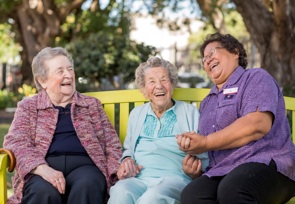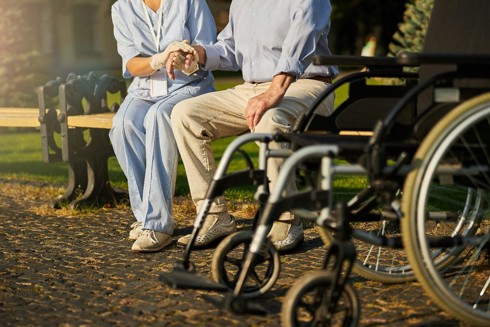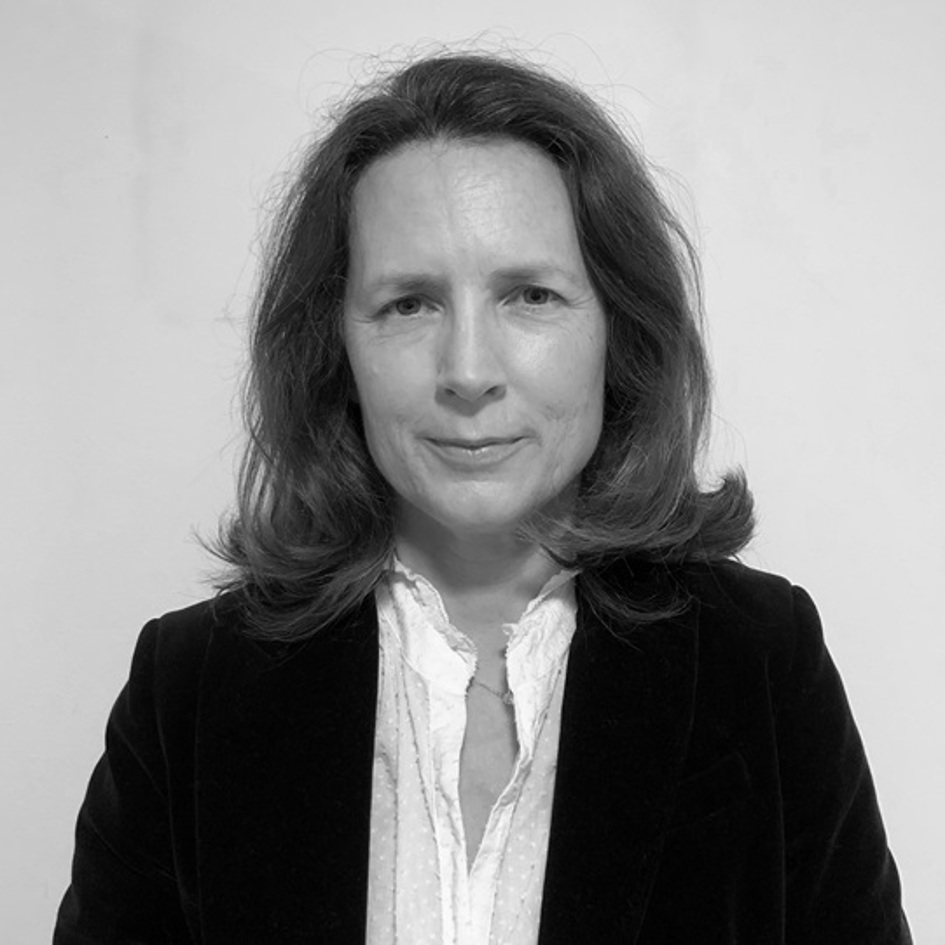Overview of this step
- What are the basic aged care fees Begin 4.1
- What are the main costs of an aged care home? Begin 4.2
- How do I complete an income and assets test? Begin 4.3
- What do I need for the income and assets test? Begin 4.4
- How is my family home assessed? Begin 4.5
- What debt details do I need to provide on the income and assets test? Begin 4.6
- What are the options for my contribution to age care costs? Begin 4.7
- How do I calculate my daily accommodation payment (DAP)? Begin 4.8
- What are my financial options to move into an aged care home? Begin 4.9
- Am I entitled to financial hardship assistance? Begin 4.10
Handy Hint - Did you know that if you can click the CC at the bottom righthand side while the video is playing, captions will appear. To get rid of them, click CC again.
View transcript of video here4.1 What are the basic aged care fees?
Basic fees and costs
Before you ‘sign up’ for an aged care home (nursing home), you need to know what fees and costs you will be expected to pay – and what you can afford.
Aged care homes can charge you four types of fees and costs as described in 4.2 The Main Costs Explained.
In summary, these are:
- A Basic Daily Fee
- Hotelling supplement
- Non-clinical care contributions
- An accommodation cost
Plus:
- An optional Higher Everyday Living Fee
What you need to know:
- The Australian Government subsidises a lot of the cost of aged care but you will have to pay some of them, depending on an assessment of your income and assets.
- This assessment is done by the Services Australia or the Department of Veterans’ Affairs.
- You can choose not to have a means test but it is strongly recommended even if you are not counting on government support.
- Fees set by the government are increased twice a year – 20 March and 20 September – in line with increases to the Age Pension.
- You can download a copy of the current schedule of fees and charges at schedule of fees and charges here.
- If you can’t afford to pay for aged care services, the Commonwealth government will cover the costs of your government subsidised aged care home.
I have a question. I'm already an aged care resident but I've heard there's a new aged care system coming in. Will my fees change under the new system?

Under the new aged care system, existing aged care residents will have their fees 'guard fathered' which means how much you pay won't change. However, you can opt into the new system if you wish, but it's important to understand the financial consequences if you do. Speak to a trusted person who understands the financial implications before you decide.
Annie Donaldson
agedcare101 Registered Nurse and Carer
4.2 What are the main costs of an aged care home?
Main costs of aged care
The five types of fees and costs are explained in the detail in this section.
- A Basic Daily Fee
- Hotelling Supplement
- Non-clinical care contributions
- Accommodation costs
- An optional Higher Everyday Living Fee
Basic Daily Fee
The basic daily fee covers day to day living costs such as meals, laundry, cleaning and utilities like power and basic telecommunications.
The basic daily fee is set by Services Australia at 85 per cent of the single Age Pension.
Because the Age Pension is increased or ‘indexed’ twice a year to keep up with rising costs of living, the basic daily fee increases twice a year too.
The daily fee is the same for everyone, whether or not you receive the Age Pension.
Remember
You can never be charged more than 85% of the single age pension for your basic daily fee at a government subsidised aged care home.
As a guide, as of 1st November 2025, the maximum basic daily fee is: $65.55 per day.
Because it is tied to the Age Pension rate, this amount goes up twice a year on the following dates each year and you will be notified of the new fee each time:
- 20th March
and:
- 20th September
For some people, the basic daily fee will be the only fee they will need to pay.
Means-tested care fee
If you entered residential aged care before 1st July 2025, you may pay a means-tested fee, a fee for your day-to-day personal care and nursing costs depending on an assessment of your income and assets. Under the new system's 'grandfathering' arrangements and 'no worse off principle' the amount you pay will not increase.
Hotelling Supplements
Depending on the outcome of your means test, you may have to pay a fee towards your daily living costs such as the cost of meals, cleaning and laundry.
You will be required to pay the Hotelling Supplement if you have:
- assets of more than $238,000
or
- income of more than $95,400
or
- a combination of these amounts
The maximum Hotelling Supplement will be $12.55 per day.
Non-clinical Care Contributions
The government will pay for all your clinical care costs in residential aged care. If the means test requires you to pay the full Hotelling Supplement you may also be required to pay a Non-Clinical Care Contribution, which covers costs such as bathing, help with mobility and a program of activities and entertainment.
From 1st July 2025, the Non-Clinical Care Contribution replaces the means Test Care Fee.
The Non-Clinical Care Contribution is based on a means assessment of your income and assets. Your contribution will depend on this. There is a daily limit on the non-clinical Care Contribution of $101.16.
There is a cap on the Non-Clinical Care Contributions of either:
- $130,000
or
- 4 years
whichever is reached first.
Accommodation Costs
The aged care home can charge a fee for the accommodation they provide. This covers the bricks and mortar and maintenance costs.
The fee is set by individual aged care homes and all homes must clearly advertise their accommodation price.
The accommodation fee will vary according to factors such as local property prices, the type and size of the room and amenities provided (eg. gym, swimming pool, gardens).
Remember - While Commonwealth subsidised aged care homes can set the price they want to charge for accommodation, if they want to charge more than $750,000 as a Refundable Accommodation Deposit or its equivalent it needs to be approved by the Independent Health and Aged Care Pricing Authority.
How much do you have to pay?
You might have to pay the full price of your accommodation or the Australian Government might pay some or most of it – it depends on your finances.
Like the Hotelling Supplements and the Non-Clinical Care Contribution, Services Australia decides this, based on their assessment of your income and assets.
The government can subsidise your accommodation costs, but you may need to pay part of the cost.
You will be advised by Services Australia what you will be expected to pay, which will be one of the following:
- Subsidised accommodation costs: if your income and assets are below a certain amount, the Australian Government will subsidise your accommodation costs. The amount that is subsidised will be based on how recently the aged care home was refurbished. The maximum accommodation supplement amount is $69.79 per day. If the room is not newly built or significantly refurbished then the subsidised cost will be less. If the Daily Accommodation Payment of the room is more than the maximum accommodation supplement, then the resident will be liable to pay the shortfall.
- An accommodation contribution: you might be required to pay part of the cost of your accommodation and the Australian Government will pay the rest.
- An accommodation payment: if you are required to pay for the full cost of your accommodation.
How do you pay accommodation costs?
There are three ways you can pay:
- a lump-sum Refundable Accommodation Deposit – known as a RAD for short
- a regular rental-type payment called a Daily Accommodation Payment – known as a DAP for short
Plus:
- a combination of both
You can move into an aged care home before deciding how you want to pay. You then have 28 days to decide. Until that point, you will make a daily accommodation payment.
Remember
- If you have moved to the aged care home at short notice and you haven’t been means-tested, then you can be asked to pay the Daily Accommodation Payment (DAP) as an interim measure. This will be refunded if it later emerges that you do not need to pay it.
- If the means test means you are liable to pay the full accommodation price, then the entry price you pay is fixed for the duration of your stay.
- If you are making a contribution to the accommodation cost then this may fluctuate over time depending on changes to your income and assets or if the facility becomes eligible for the higher accommodation supplement.
- You can’t be charged for your accommodation if you are receiving respite care.
Fees for additional services
There may be extra costs depending on the choices you make. For example, some aged care homes offer rooms that are a higher standard or larger than others, and some offer additional services:
- Pay television
- Phone, internet
- Onsite hairdresser, beautician
- Special therapies such as massage, aromatherapy, hydrotherapy
- Facilities like a gym, pool, cinema, workshop, library etc.
- Having a newspaper delivered to your room
Plus:
- A bigger choice of meals and inclusions such as beer, wine and spirits
When you are choosing an aged care home, each home will tell you about the potential additional services and fees before you move in.
Such charges are not regulated or subsidised by the government. You will have to pay for them yourself.
Higher Everyday Living Fees (HELF)
Some aged care homes offer a higher standard of services, such as higher quality furnishing, specialised menus, or higher quality linen. These homes can charge. The additional goods and services must be significantly higher quality than those providers are obligated to provide.
You only agree to additional goods and services and a Higher Everyday Living Fee after you move into residential aged care.
you can't pay for additional goods or services that you aren't able to use, for example you can't be asked to pay for an additional cooked breakfast if you have swallowing difficulties.
4.3 How do I complete an income and assets test?
To receive a Commonwealth subsidy for some or all of your care and accommodation costs, you must have a means test called the Income and Assets Test.
It can take four to six weeks to get the results so it’s a good idea to apply for the assessment as soon as possible.
You can enter an aged care home before the income and assets test is completed because it may be that you don't have time to wait. It makes things much easier if you have done the assessment and you know the outcome - it will tell you how much you'll have to pay. You can do the assessment ahead of time and if your circumstances change by the time you enter the home then the assessment can be updated.
Remember
You can enter an aged care home before the income and assets test is completed because it may be that you don't have time to wait.
- downloading it from the website
- Calling Services Australia on 1800 227 475 and having one posted to you.
Return the completed form to Services Australia or the Department of Veterans’ Affairs. The instructions are on the form.
Services Australia will send you a letter with the results of your assessment. This will tell you how much, if anything, you need to pay towards the cost of your care and accommodation.
In the meantime, you can get an estimate of the fees and costs you may have to pay by using the Aged Care Fee Estimator.
Remember:
- It can take between four and six weeks for the assessment to come through but you can still move to an aged care home in that time
- You can have an aged care assessment while you are waiting for your income and assets assessment to come through.
- Your income and assets assessment is valid for 120 days.
- You don’t have to do separate income and assets assessment forms for each aged care home you want to apply for.
- If you are part of a couple you will each have to complete an income and asset assessment.
You don't have to wait for an aged care assessment to apply for the income and asset assessment.
4.4 What do I need for the income and assets test?
What you need for the income and assets test
You will need to provide details of your income and assets so the government can assess if you can pay for some or all of your care and accommodation costs.
Whether single or in a couple, every person seeking to move to an aged care home (nursing home) needs to complete their own assessment.
If you are part of a couple and only one of you is moving to an aged care home, then only that person needs to complete the form.
If you are part of a couple, you will be assessed on 50% of the two of your combined income and assets.
You will be considered to be a member of a couple:
- If you are legally married (unless you are living separately or permanently apart)
Plus:
- If you are living in a de facto relationship (regardless of gender)
*For aged care purposes, if you are permanently living apart for health-related reasons, you are still considered to be a member of the couple.
The family home is counted as an asset unless someone else is living in it, such as:
- Your partner
- A dependent child (children)
- A close relative who is eligible for an income support payment from the Australian Government and has been living there for at least five years
Plus:
- A carer who is eligible for an income support payment from the Australian Government and has been living in the home for at least two years
However, the assessment does NOT include the full value of your home. See Details of your financial assets below to see how your family home is treated under the combined income and assets assessment.
Details of your income
Your income includes:
1. Income support payments from the Australian Government
For example:
- the age pension
- a service pension
Plus:
- an income support supplement
2. Deemed* (not actual) income from financial investments
- bank, building society and credit union accounts
- cash
- term deposits
- cheque accounts
- friendly society bonds
- managed investments
- listed shares and securities
- loans and debentures
- shares in unlisted public companies
- gold and other bullion
- account-based income streams from 1 January 2015.
- net income from rental property - the rental income from a property minus the expenses incurred
- War Widow or Widower Pensions and some disability pensions
- Net income from businesses including sole trading and farms
- Superannuation income
- Overseas pensions, and income from income stream products such as annuities and allocated pensions
- Family trust distributions or dividends from private company shares
- Deemed* income from excess gifting.
(The Department of Human Services has rules around gifting your income and assets to family members or others, including limits on allowable amounts. See the Department of Human Services website on this here.)
Note: * ‘Deemed’ income refers to an assumed rate of income earned from bank accounts and other financial investments – as opposed to the actual earnings - that the Department of Human Services uses when assessing your income. If you ‘actually’ earn more than the ‘deemed income’, the extra amount is ignored.
Current deeming rates are provided on the Schedule of Residential Fees and Charges.
Details of all your financial assets
For the combined income and assets assessment, your financial assets include:
Financial investments
- bank, building society and credit union accounts
- cash
- term deposits
- cheque accounts
- friendly society bonds
- managed investments
- listed shares and securities
- loans and debentures
- shares in unlisted public companies
- gold and other bullion.
Household Content and Personal Effects
- These are typically valued at $10,000
Foreign Assets
- Including investments, business interests and real estate
Investment Property
- The value of any real estate, apart from your principal home, is included in your assets test, whether it is wholly or jointly owned by you and your partner, privately or within a business structure.
Special Collection Values
- Such as stamps, art works or antiques
Superannuation Balances
- You must include the value of your superannuation balance if you are over the qualifying age for the age pension but have not drawn an income stream from your superannuation
- Do not include your superannuation assets if you are over the qualifying age for the age pension and have started receiving an income stream. In that case, you need to record the income received in superannuation under your INCOME. The balance of your superannuation account should be recorded under ‘Other Assets’.
- Do not include your superannuation account balance if you are below the qualifying age for the age pension.
Private trusts, family trusts and private companies
- If you control a private trust or private company, the assets (as well as the income) of that trust or company are included.
Net retirement village entry contributions
- The amount of entry contribution you pay to live in a retirement village affects whether you are considered to be a home owner and if the amount will be included in your assets assessment.
Refundable accommodation deposits (RADs)
- Paid for accommodation in an aged care home (nursing home)
Gifts
- If you have gifted away any assets over the allowable limit of $10,000 in a single financial year or $30,000 over five financial years, the amount over these limits must be included
Your family home
- The family home is counted as an asset unless there is someone else living in it, such as:
- Your partner
- A dependent child (children)
- A close relative who is eligible for income support payment from the Australian Government and has been living there for at least five years
- A carer who is eligible for income support payment from the Australian Government and has been living in the home for at least two years
The family home is assessed differently to other assets. See details at 4.5 amount that can be included in the assessment is capped by the government.
4.5 How is my family home assessed?
Assessing the family home
The family home is treated differently to other assets.
The family home is not counted as an asset if there is still someone living in it such as:
- Your partner
- A dependent child (children)
- A close relative who is eligible for income support from the Australian Government and has been living there for at least five years
Plus:
- A carer who is eligible for income support from the Australian Government and has been living there for at least two years
A cap on the value of your family home
The Home Exemption Cap (which applies separately to both members of a couple*) the actual amount is increased (or 'indexed') twice a year on:
- 20th March
- 20th September
The Department of Human Services publishes the Home Exemption Cap here
At 1st November 2025, the capped amount on the value of your home is $210,555.20.
If you are part of a couple and your home is included as an asset, 50 per cent of the net market value of the home is attributed to each of you. Each 50 per cent proportion will be subject to the full value of the cap.
4.6 What debt details do I need to provide on the income and assets test?
Debts
As well as your income and assets, you will be asked to provide information about your debts. Any debt secured against an asset is deducted from the value of that asset.
For example:
A mortgage
This includes a mortgage that has been taken out for somebody else’s benefit.
Personal loans
Only include a personal loan for assets on your assets list e.g. for a car.
Any other loans
This refers to any loan, charge or debt held over a financial or other asset you have already listed.
Credit card debt is not included in the assessment
4.7 What are the options for my contributions to age care costs?
Contribution to age care costs
Once you know the result of your income and assets assessment, you will know whether you will be contributing to your care and accommodation costs and how much it will be. There are four types of costs involved.
These are explained in section 4.2 – The main costs explained, the costs are:
- Basic daily fee - fixed price, set at 85 per cent of the single Aged Pension see 4.2 The main costs explained. Currently (1st November 2025) that fee is $65.55 per day.
- Hotelling Supplement - you cannot know this amount until you receive the assessment from Services Australia
- Non-Clinical Care Contributions - the amount you pay will depend on your assets and income.
- Accommodation costs - You may have to pay some or all of the accommodation costs, depending on your means test.
Plus:
- a lump-sum refundable accommodation deposit – known as a RAD
- a regular rental-type payment called a daily accommodation payment – known as a DAP
Or:
- a combination of both
About the RAD
A RAD is a lump sum payment that is partly refunded to you or your family when you leave the home. The RAD works like a loan, to the provider allowing the provider to invest and earn interest, in order to build, improve and maintain it.
The provider is able to keep 2 per cent per annum of the RAD for every year you live there. This amount the provider can keep is capped at 5 years.
How the refund works
When you leave the aged care home, the provider is required to refund the RAD to you or your family minus the 2 percent per annum.
If you give:
- More than 14 days notice of leaving – your RAD must be refunded to you on the day you leave.
- Notice within 14 days notice of leaving – your RAD must be refunded within 14 days of you giving notice.
- No notice of leaving – your RAD must be refunded within 14 days of your leaving.
Plus:
- In the event of your death, for someone who has died without leaving a will, the aged care home must refund the RAD within 14 days of the day they were shown evidence of probate or letters of administration.
If the lump sum is not refunded by the end of these legislated time frames, the aged care home will be charged the Maximum Permissible Interest Rate on the owing amount until the RAD is fully refunded.
The Maximum Permissible Interest Rate
This higher rate of interest is called the Maximum Permissible Interest Rate (or MPIR). This amount is reviewed by the Australia Government per quarter. As of 1st October 2025 - 31st December 2025, the Maximum Permissible Interest Rate sits at 7.61%. This rate kicks in from the day after you should have been refunded your refundable deposit balance and it acts as an incentive for providers to pay the refund on time.
The applicable MPIR is fixed on the day you sign your agreement with the aged care home, so does not go up or down even if the rate goes up over the time you are in the aged care home.
Remember:
- When you leave the aged care home (nursing home), the balance owed to you will be refunded to you or your family. Some fees may also be taken out of your refundable accommodation deposit when you leave, such as Daily Accommodation Payments. Pre-agreed arrangements must be detailed, approved and signed in the agreement that you sign with your aged care home.
- The interest earned on this lump sum is retained by the aged care home.
Plus:
- Your loan is fully backed by the Australian Government. The Government sets strict rules about how the aged care home can invest this money and criminal penalties can be imposed for misuse of these funds.
About the DAP
The Daily Accommodation Payment (DAP) is simply a refundable accommodation deposit (RAD) converted to a daily payment. DAP payments are not refundable. The benefit of a DAP is that it might be an easier option than paying a lump sum up front.
A Daily Accommodation Payment is calculated by multiplying the RAD by the maximum permissible interest rate (MPIR) and dividing the result by 365 days.
It is calculated in the following way:
DAP = (RAD x MPIR) ÷ 365
Below is an example using a RAD of $350,000 and a MPIR of 7.61% (current at October 2025)
DAP = ($ 350,000 x 7.61%) ÷ 365
DAP = ([$ 350,000 ÷ 100] x 7.61) ÷ 365
DAP = ($ 3,500 x 7.61) ÷ 365
DAP = $ 26,635 ÷ 365
DAP = $ 72.97
A combination of RAD and DAP payments
You can make a combination of RAD and DAP payments. The more you pay upfront via the RAD, the lower the DAP payment will be.
Below is an example of a combined RAD and DAP payment based on a RAD of $350,000. In this example, the resident has $125,000 money available for a part payment of the RAD. This means that the DAP is worked out on the remaining RAD amount of $225,000.
DAP = ($ 225,000 x 7.61%) ÷ 365
DAP = ([$ 225,000 ÷ 100] x 7.61) ÷ 365
DAP = ($ 2,250 x 7.61) ÷ 365
DAP = $ 17,122.50 ÷ 365
DAP = $ 46.91
So here instead of paying the full RAD of $350,000 you would pay a part payment of a RAD of $125,000 as well as a DAP of $46.91.
4.8 How do I calculate my daily accommodation payment (DAP)?
Convert your refundable accommodation deposit (RAD) to a daily accommodation payment (DAP) using this quick and simple calculator. Save time and understand your aged care costs using this free tool.
4.9 What are my financial options to move into an aged care home?
Reverse Mortgage
This is also known as Equity Release.
If you own your house outright you can borrow against the value of your house. There are no repayments (although you can make a repayment if you wish). You repay the loan when you sell the house or when the last borrower passes away.
Interest rates on reverse mortgages tend to be higher. and are added to the loan balance each month - they can add appreciably to the debt.
When a home loses value or if the borrower stays in the home for many years the loan amount can eventually exceed the value of the home. Usually, however, the borrower (or their estate) does not have to repay any additional loan balance. When you apply for a reverse mortgage, always be sure to get a 'no negative equity' guarantee.
You can receive a reverse mortgage as a lump sum or it can be available with a redraw facility so the owner can draw down money as they need it.
You won't get a reverse mortgage for the full value of your property. Typically it is between 30 and 50 percent of the property's value.
Know that particularly in times of declining home values or if the borrower continues to live in the home for many years the rising loan balance can eventually grow to exceed the value of the home.
Selling the family home
Personal circumstance and what has been negotiated with the aged care home will decide whether or not you decide to sell the family home prior to entering an aged care home.
If you do not sell your home to move into an aged care home it will be exempt from the age pension assets test for two years from the date you move into the aged care home. For more information call the Department of Human Services on 132 300.
The lump sum paid to an Aged Care provider is exempt from the Aged Care Combined Assets and Income Assessment.
Renting out your home
If you rent your home to cover the periodic payments in an aged care home, the rental income is counted for the Combined Income and Assets Test used for means-tested daily care fees.
4.10 Am I entitled to financial hardship assistance?
Financial Hardship Assistance
For further information about aged care costs and managing your finances you can contact Centrelinks Financial Information Service (FIS) on 132 300 (local call cost). They can help you estimate how much you may have to pay towards your residential aged care. Your details of your various forms of income and assets ready before you call.
If you are experiencing financial hardship you can apply for help with accommodation payments, the daily care fee, means tested fee or respite care costs. This is different to being a 'supported resident'
The Department of Social Services will assess your income and assets closely.
You can't qualify for help if your assets are being retained for beneficiaries or have been gifted within the last five years.
Download the application form here.























